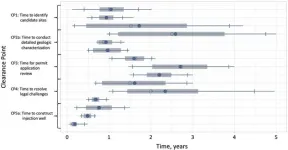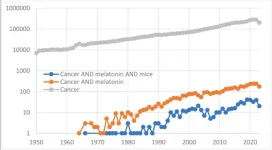Doctor Who festive specials linked to lower death rates
2023-12-19
A new Doctor Who episode shown during the festive period, especially on Christmas Day, is associated with lower death rates in the subsequent year across the UK, finds a study published in the Christmas issue of The BMJ.
The findings highlight the positive effect doctors can have when working during the festive period and may prompt the BBC and Disney+ to broadcast new episodes of Doctor Who every festive period, ideally on Christmas Day, says the author.
Sixty years ago, the ...
Hospital coffee machines get a clean bill of health
2023-12-19
Healthcare workers will be relieved to know that hospital coffee machines are not responsible for spreading disease and a general ban doesn’t seem necessary, finds a study published in the Christmas issue of The BMJ.
In a bid to eliminate hospital acquired (nosocomial) infections, various objects have been investigated as breeding grounds for bacteria including doctors’ ties and even hospital Bibles.
But despite being regularly touched by lots of bare hands, the potential of hospital coffee machines as a source of infection had not previously been explored.
To address this, researchers in Germany assessed the microbial population in healthcare associated coffee machines, ...
Common drug for cardiac failure jams a debated blood test for Alzheimer’s disease
2023-12-19
Alzheimer’s disease (AD) is associated with damaging protein aggregates in the brain, with β-amyloid (Aβ) aggregates called plaques being the key pathology. Entresto (sacubitril/valsartan) is a combined neprilysin inhibitor and angiotensin receptor blocker, approved for the treatment of heart failure. Concerns were raised by the FDA that this neprilysin inhibition treatment may increase the risk of AD, since neprilysin is one of the main enzymes responsible for degrading Aβ in the brain. The PERSPECTIVE trial (NCT02884206) showed that 3-year neprilysin inhibition treatment was not associated ...
Disadvantaged children’s struggles at school have “little to do” with character, attitude or a lack of ‘growth mindset’
2023-12-19
The relative underperformance of disadvantaged students at school has little do with them lacking the ‘character’, attitude, or mindset of their wealthier peers, despite widespread claims to the contrary, new research indicates.
The study, which analysed data from more than 240,000 15-year-olds across 74 countries, challenges the view often invoked by politicians and educators that cultivating self-belief or ‘growth mindsets’ can reduce class-based learning gaps. Researchers found that no more than 9% of the substantial achievement gap between ...
Unveiling molecular origami: A breakthrough in dynamic materials
2023-12-19
Origami, traditionally associated with paper folding, has transcended its craft origins to influence a diverse range of fields, including art, science, engineering, and architecture. Recently, origami principles have extended to technology, with applications spanning solar cells to biomedical devices. While origami-inspired materials have been explored at various scales, the challenge of creating molecular materials based on origami tessellations has remained. Addressing this challenge, a team of researchers, led by Professor Wonyoung Choe in the ...
Scientists spread festive cheer as research reveals Christmas dinner can be healthy
2023-12-19
In less than a week’s time, families around the country will be sitting down to tuck into their traditional Christmas dinner.
While the festive season is often a time of overindulgence, could parts of a festive banquet actually help improve our health?
Experts at Newcastle University, UK, have been researching the different characteristics and compounds of festive trimmings and have found that some of the side-dishes offer significant benefits.
Fighting chronic conditions
Soggy sprouts should be off the menu say Newcastle researchers – ...
U.S. utilities on track to be 100% renewable by 2060
2023-12-18
Utilities in the United States have pledged to transition to 100% renewable electricity by 2060, and although state mandates have played a role, it’s the utilities, themselves, that are leading the transition.
“Many people feel the transition on the policy side isn’t going fast enough,” said Matthew Burgess, a CIRES fellow, CU Boulder assistant professor, and co-author of the paper published today in Climatic Change. “But the private sector is moving faster than we thought. A lot has ...
Giant bacterium uses unique processes to power itself
2023-12-18
Not all bacteria are created equal.
Most are single-celled and tiny, a few ten-thousandths of a centimeter long. But bacteria of the Epulopiscium family are large enough to be seen with the naked eye and 1 million times the volume of their better-known cousins, E. coli.
In a study published Dec. 18 in Proceedings of the National Academy of Sciences, researchers from Cornell and Lawrence Berkeley National Laboratory have for the first time described the full genome of one species of the family of giants, which they’ve named Epulopiscium viviparus.
“This incredible giant bacterium is unique and interesting ...
Quantifying barriers to establishing sequestration wells
2023-12-18
Carbon capture and sequestration (CCS), the process of capturing and storing atmospheric carbon dioxide, is one method of reducing the amount of carbon dioxide in the atmosphere in efforts to reduce the impacts of climate change. While CCS is an essential tool in decarbonizing the U.S. economy, there are barriers that exist to the development, approval, and implementation of a geologic sequestration site, as it requires an appropriate geologic formation, as well as an approved injection facility.
Recent work from the Carnegie Mellon University Department of Engineering and Public Policy (EPP) estimates the time required to develop, approve, and implement ...
Sylvester cancer researcher and technology innovator named fellow of the National Academy of Inventors
2023-12-18
MIAMI, FLORIDA (Dec. 18, 2023) – Shanta Dhar, Ph.D., assistant director of Technology and Innovation at Sylvester Comprehensive Cancer Center at the University of Miami Miller School of Medicine, has been named a fellow of the National Academy of Inventors.
Her research focuses on ways to overcome barriers to precisely target mitochondria – the part of each cell that generates the energy needed for biochemical reactions. Her inventions and innovative contributions in nanomedicine, mitochondria-targeted drug delivery, and platinum-based prodrugs help guide targeted therapies in cancer and other diseases.
Dhar, an associate professor of biochemistry and molecular biology ...
Team led by UMASS Amherst discovers how to sabotage antibiotic-resistant ‘superbugs’
2023-12-18
Antibiotic-resistant “superbugs” that can defeat efforts to kill them are an urgent public health crisis, and according to the Centers for Disease Control, more than 2.8 million antibiotic-resistant infections occur each year. Researchers across the world are scrambling to meet the challenge. A collaborative team of researchers led by the University of Massachusetts Amherst and including scientists from the biopharmaceutical company Microbiotix recently announced that they had successfully learned how to sabotage a key piece of machinery that pathogens use to infect their host cells, and have developed a test to identify the next-generation drugs ...
How effective are opioid medications for cancer pain?
2023-12-18
Researchers examining the data on opioids for pain caused by cancer have found surprisingly large gaps in evidence regarding the true benefits of these medicines for cancer pain. The review challenges the commonly held view that opioids are the most powerful pain relievers.
The University of Sydney-led review highlights there is no ‘one size fits all’ treatment approach for cancer pain, urging health professionals and patients to carefully weigh up the evidence when deciding on a suitable pain management plan.
Opioid pain relievers are the most common treatment for cancer pain management. Many international guidelines including the ...
Firearms and hanging top methods for suicide in US as rates continue to rise
2023-12-18
Embargoed for release until 5:00 p.m. ET on Monday 18 December 2023
Annals of Internal Medicine Tip Sheet
@Annalsofim
Below please find summaries of new articles that will be published in the next issue of Annals of Internal Medicine. The summaries are not intended to substitute for the full articles as a source of information. This information is under strict embargo and by taking it into possession, media representatives are committing to the terms of the embargo not only on their own behalf, but also on behalf of the organization they represent.
----------------------------
1. ...
B cell deficient patients gain protective T cell immunity following SARS-CoV-2 vaccination and infection, study finds
2023-12-18
B cell deficiency is a common condition that can result either from immunosuppressant drugs used to treat autoimmune disease or certain cancers — such as rituximab (RTX) — or from natural immune deficiency. These patients suffer from a weakened immune system that is less effective at combating both viral and bacterial diseases. As B cells are a key type of immune cell that produces antibodies, a deficiency results in a significant decrease in antibody count that can lead to severe disease or death upon infection with SARS-CoV-2.
Researchers at the Ragon Institute of Mass General, MIT, and ...
New guidelines released for practitioners treating anaphylaxis and atopic dermatitis
2023-12-18
ARLINGTON HEIGHTS, Ill. – (December 18, 2023) — Two new practice parameters from the Joint Task Force for Practice Parameters (JTFPP) offer evidence-based recommendations for the diagnosis and management of anaphylaxis and atopic dermatitis (AD) in pediatric and adult patients. The Joint Task Force is a partnership between the American College of Allergy, Asthma and Immunology (ACAAI) and the American Academy of Allergy, Asthma and Immunology.
“Both anaphylaxis and atopic dermatitis are allergic conditions that affect millions of people – in the United States and around the world,” says allergist Jay Lieberman, MD, co-chair of the JTFPP ...
Spike in dermatology visits for skin problems seen during summer of wildfires
2023-12-18
New research suggests that air pollution may contribute to the development or worsening of skin conditions.
The work, which is published in Dermatology and Therapy and led by scientists at Massachusetts General Hospital (MGH), a founding member of the Mass General Brigham healthcare system, points to the need to improve air quality to lower the burden of skin disease, especially for vulnerable communities.
“We were inspired to investigate the relationship between air pollution and skin inflammation after listening to patients who kept telling us that their skin conditions like eczema were particularly bad, and in some cases ‘worse than ever before,’ this summer,” ...
Melatonin and carcinogenesis in mice: The 50th anniversary of relationships
2023-12-18
“[...] murine models proved to be valuable and, in some cases, indispensable for advancing melatonin applications in oncology [...].”
BUFFALO, NY- December 18, 2023 – A new research perspective was published in Oncotarget's Volume 14 on December 12, 2023, entitled, “Melatonin and carcinogenesis in mice: the 50th anniversary of relationships.”
Fifty years ago, in 1973, Vladimir N. Anisimov and coauthors demonstrated for the first time an inhibitory effect of the pineal ...
Yale study finds “Forever chemicals” promote cancer migration
2023-12-18
New Haven, Conn. — In a new study by researchers at the Yale School of Public Health, two “forever chemicals” spurred cancer cells in the lab to migrate to new positions, an indication that the chemicals could contribute to cancer metastasis in living organisms.
The study addressed the group of industrial chemicals called per- and polyfluoroalkyl substances (PFAS). The substances are known as “forever chemicals” because they don’t break down in the environment and can build up in the human body. They have the ability to shed water and resist penetration by oils. They are ...
New survey: 79% of survey respondents overlook their health needs during the holidays; find the holidays more stressful than tax season
2023-12-18
Survey Highlights:
A majority of Americans (51%) say it takes them weeks to feel less stressed after the holidays, with more than a quarter of moms reporting it takes them a month or more to recover.
71% of respondents say that their biggest regret after the holidays is that they did not take the time to relax and enjoy the season.
Overall, respondents (63%) claimed that the holiday season is more stressful than tax season.
Eating healthy (69%), exercising regularly (64%), and getting enough sleep (56%) are the top three things that respondents have trouble prioritizing during the holiday season.
79% of people surveyed agree that, during the holidays, they are so focused on creating special ...
Public opinion polls may not be as straightforward as you think
2023-12-18
Public opinion polls are often considered "the will of the people" but a new study on the role of polls in South Korea shows that they may not always be that transparent.
"Using polls to gauge what people think about politics is not as simple as it sounds, as there are multiple mediating factors between what people think and how their views may be represented in the media," says co-author Sunmin Kim, an assistant professor of sociology at Dartmouth. "Our research shows more broadly, how in a democracy, measuring what people think or want can be a highly haphazard and unpredictable process based on the ways public opinion poll ...
Study assesses GPT-4’s potential to perpetuate racial, gender biases in clinical decision making
2023-12-18
A team of Brigham researchers analyzed GPT-4’s performance in four clinical decision support scenarios: generating clinical vignettes, diagnostic reasoning, clinical plan generation and subjective patient assessments.
When prompted to generate clinical vignettes for medical education, GPT-4 failed to model the demographic diversity of medical conditions, exaggerating known demographic prevalence differences in 89% of diseases.
When evaluating patient perception, GPT-4 produced significantly different responses by gender or race/ethnicity for 23% of cases.
Large language models (LLMs) like ChatGPT and GPT-4 have the potential to assist in ...
Apes remember friends they haven’t seen for decades
2023-12-18
Apes recognize photos of groupmates they haven’t seen for more than 25 years and respond even more enthusiastically to pictures of their friends, a new study finds.
The work, which demonstrates the longest-lasting social memory ever documented outside of humans, and underscores how human culture evolved from the common ancestors we share with apes, our closest relatives, was published today in the journal Proceedings of the National Academy of Sciences.
“Chimpanzees and bonobos recognize individuals even though they haven’t seen them for ...
Scientists might be using a flawed strategy to predict how species will fare under climate change
2023-12-18
EMBARGO LIFTS DEC. 18, 2023, AT 3:00 PM U.S. EASTERN TIME
As the world heats up, and the climate shifts, life will migrate, adapt or go extinct. For decades, scientists have deployed a specific method to predict how a species will fare during this time of great change. But according to new research, that method might be producing results that are misleading or wrong.
University of Arizona researchers and their team members at the U.S. Forest Service and Brown University found that the method – commonly referred to as space-for-time substitution – failed to accurately predict how a widespread tree of the Western U.S. called the ...
Mesopotamian bricks unveil the strength of Earth’s ancient magnetic field
2023-12-18
Ancient bricks inscribed with the names of Mesopotamian kings have yielded important insights into a mysterious anomaly in Earth’s magnetic field 3,000 years ago, according to a new study involving UCL researchers.
The research, published in the Proceedings of the National Academy of Sciences (PNAS), describes how changes in the Earth’s magnetic field imprinted on iron oxide grains within ancient clay bricks, and how scientists were able to reconstruct these changes from the names of the kings inscribed on the bricks.
The team hopes that using this “archaeomagnetism,” which looks for signatures ...
Move over dolphins. Chimps and bonobos can recognize long-lost friends and family — for decades
2023-12-18
Researchers led by a University of California, Berkeley, comparative psychologist have found that great apes and chimpanzees, our closest living relatives, can recognize groupmates they haven't seen in over two decades — evidence of what’s believed to be the longest-lasting nonhuman memory ever recorded.
The findings also bolster the theory that long-term memory in humans, chimpanzees and bonobos likely comes from our shared common ancestor that lived between 6 million and 9 million years ago.
The team used infrared eye-tracking cameras to record where bonobos and chimps gazed when they were shown side-by-side images of other bonobos ...
[1] ... [1356]
[1357]
[1358]
[1359]
[1360]
[1361]
[1362]
[1363]
1364
[1365]
[1366]
[1367]
[1368]
[1369]
[1370]
[1371]
[1372]
... [8705]
Press-News.org - Free Press Release Distribution service.








